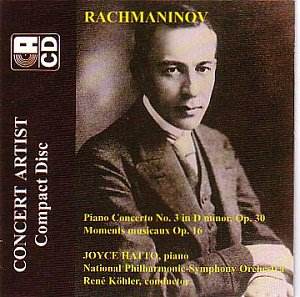There’s no long orchestral exposition here to give
the soloist time to warm the stool, just a couple of bars of "on
your marks" music then off she goes. Still, it’s all right, because
she’s given beginners’ music to play, just a simple melody in octaves.
Even the reviewer would be able to play the first couple of minutes
of this particular concerto, and what a wonderful time he would have!
All the same, I suspect that it’s actually easier for the soloist to
begin with more demonstrative music – massive chords à la Tchaikovsky
1 or hair-raising semi quavers (after a ravishing orchestral introduction)
as in Prokofiev 3 – than music as simple as this which, at the same
time, represents a major part of the thematic material of the whole
work. Well, Joyce Hatto will be relieved to know that she has nothing
to fear from me. She delivers this opening melody most sensitively,
her playing limpid and poised. At the same time she manages, as is the
way of a great artist, to inject this very simple music with all its
import and meaning, engaging the listener’s attention from the outset.
The arrival of the solo bassoon to play in duet with her after a few
bars demonstrates another feature of this performance: the outstanding
quality of the solo wind playing. Miss Hatto’s feeling for rubato
– around 4.00 in this first movement is a good example – demonstrates
a profound sympathy with the Rachmaninov style, and when this same music
returns in the recapitulation the calm she communicates is quite magical.
She plays the longer, more difficult of the two cadenzas Rachmaninov
provided. This was apparently the one the composer preferred, even if
he played the shorter one when he recorded the concerto himself with
Eugene Ormandy.
The slow movement is more elusive than the other two,
and may even seem inconsequential in comparison. Rachmaninov calls it
an intermezzo, which goes some way to explaining this. I think it is
particularly difficult to bring off, technical issues aside, and in
spite of some beautifully characterful playing from both the soloist
and the orchestra I do find the more withdrawn passages of the movement
a shade less communicative than what has gone before. No such suspicion
can be entertained about the more brilliant central section, however.
There is again some beautiful duet playing, starting around 7.00, first
with the flute then with the horn. The finale, which follows without
a break, is superbly played, very rhythmic and march-like when required
and movingly poetic in the more passionate, yet strangely fragile, second
theme. Joyce Hatto has all the technical means at her disposal, from
rapid pianissimo playing to enormous power when called for. She communicates
her view of the concerto direct to the listener, who is, I submit, totally
convinced. "With a safe pair of hands," the liner notes tell
us, speaking of the end of the work, it "rarely fails to bring
the audience to its feet." Miss Hatto’s are certainly a safe pair
of hands: in this performance the music rises to a superb climax and
the work ends in stupendous fashion with a final kick on the accelerator.
Joyce Hatto receives outstanding support from the National
Philharmonic-Symphony Orchestra. It doesn’t matter who they are, their
playing is tight and hot, with all departments equally excellent. They
accompany their soloist in a most exemplary manner, together in more
ways than one during her more fantastic moments. This is of course a
credit to the late René Köhler who conducts the work with
the utmost care and control. Particularly interesting is the way he
brings out certain subsidiary parts, often in the basses, revealing
an unexpected diversity of orchestral invention. Between them these
forces produce a performance of the third concerto as recommendable
in its own way as the two others I know best, by Martha Argerich or
Byron Janis, and praise doesn’t come higher than that.
The Moments Musicaux, are perhaps the first
of Rachmaninov’s solo piano pieces to show signs of his mature style.
They are also very interesting and lovely in their own right. I’d never
heard them before and I’m looking forward to getting to know them better.
Perhaps the 3 against 2 writing in the first piece sounds just a bit
literal in Joyce Hatto’s performance, but everywhere else I found her
playing most convincing, most of all in the dark melancholy – present
here, and so typical of the composer, even in this young man’s music
– of the third piece in B minor.
William Hedley
MusicWeb
can offer the complete Concert
Artist catalogue
